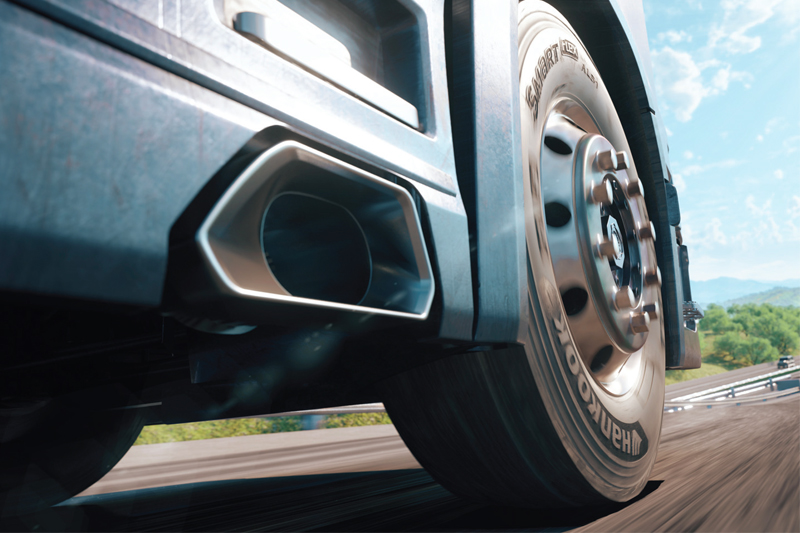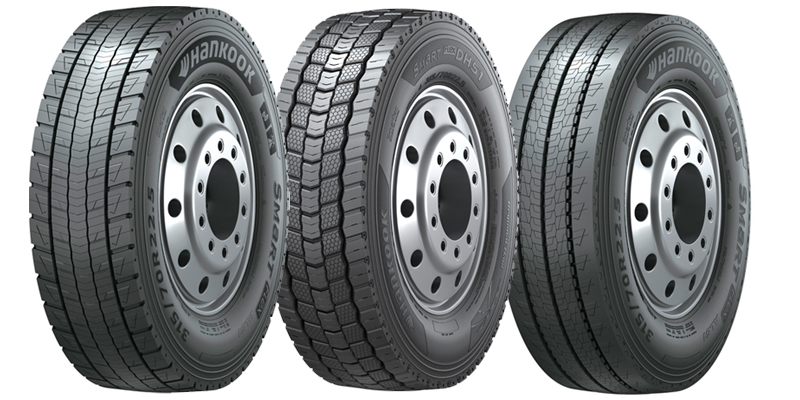How tyre pressure affects all types of vehicles

Do you know your Ackerman from your tandem scrub? They’re all part of understanding the potential causes of tyre wear. Here Hankook Tyre UK outlines how inflation pressure and wheel alignment can affect all types of vehicles.
One of the most important aspects of tyre maintenance is correct tyre inflation, that is necessary to carry the load and avoid damage. Driving with improper inflation (particularly grossly under inflated or over inflated) is dangerous and can cause critical damage or sudden failure and premature removal from service.
Hankook therefore suggests that inflation values should be checked at least once a week, and always before a long-distance drive, Indeed, in the space of one month, a tyre can lose up to 10 pounds of air pressure. It is also advisable to take into account the axle loadings for the loads imposed, when setting inflation pressures, compensation for heavier loads can be made by increasing inflation pressures – though make sure not to exceed the maximum inflation rates for the tyre, or maximum axle load.
Under inflation is the worst enemy for tyres, it causes increased tread wear on the tyre shoulders, reduces the tread contact area on the road surface and also generates excessive heat affecting the tyres durability. Soft tyres also make your vehicle work harder, meaning that fuel efficiency is reduced due to increased rolling resistance.
Over inflation, on the other hand, is also detrimental. Too much air pressure causes the centre of the tread to bear the majority of the vehicles weight, leading to more rapid wear to the tyre tread centre which will shorten the life span of the tyre. It also makes the tyre more prone to damage from road hazards due to the tyre not being able to dampen the effects of a shock.

Wheel alignment
There is actually more to alignment that most people understand. Steering axle alignment alone is not sufficient, as the vehicle and all of its tyres need to be travelling in the same direction and it is essential that that all axles are in correct alignment also.
There are various different components needed to achieve total wheel alignment:
Camber
- camber is the inward or outward tilt of the steering axle tyres when viewed from the front.
- positive camber is the top of the tyre tilted out; negative camber is the top of the tyre tilted in.
The angle that a centre line of the wheel is inclined from the vertical centre line perpendicular to a flat road, is called camber angle.
If the top of the top of the tyre is tilted out and the wheel leans out from the perpendicular then it is positive camber. If the top of the tyre is tilted in and the wheel leans in from the perpendicular then it is negative camber. Camber becomes more negative as the load increases.
Camber is meant to compensate for the downward forces of added loads; correct camber settings help the tyre to maintain a firm and even tread contact with the road while the vehicle is travelling under loaded conditions; often, one side tyre tread wear can occur on the outside or inside edge of the tyre due to incorrect camber setting.

Toe
- toe is the inward or outward pointing of the wheels when viewed from the top of the vehicle
- the goal is to have zero toe when the vehicle is loaded to its normal operating condition
Toe-in refers to the inclination of the wheels of a vehicle so that the pair of front wheels are set inwards facing.
The purpose of toe-in is to counteract some of the forces which pull the wheels outwards as they roll along the road under engine power. Correct toe-in will ensure the direction of travel is correct as possible for forward direction of travel, insufficient toein settings will result in steering instability.
If toe-in or toe-out is insufficient or excessive, tyre wear will certainly be affected and appear as feathering at the edges of the tread.
Caster
- caster is the forward or rearward tilt of the king pin of the steering axle when viewed from the side
- caster is generally not considered to have a great effect on the tyre wear
Caster is the condition where the king pin is inclined with the top of the pin angled rearward, similar to the front forks of a bicycle. Caster angle is meant to compensate for the resistance which the tyre(s) encounters as a result of drag forces against the road. Caster angle should be the same for both wheels on a given axle, or the result will be vibration and abnormal tyre wear.
Too much caster will more than compensate for the amount of drag, but it will also create additional difficulty in steering.
Too little caster makes steering become lighter, but also unstable. The caster angle should be checked as it can be distorted by impacts on the tyre or by rough driving conditions.

Ackerman
- the Ackermann principle shows that in any turn the inside tyre needs a sharper turn angle than the outside tyre
- The difference in turn angles between the tyres is determined by the actual turn angle and the vehicle wheelbase.
Improper Ackermann causes side force, excessive scuffing and fast or irregular wear.
Thrust angle
- thrust angle is the difference between the line perpendicular to the axle and vehicle center line
- each drive axle has its own thrust angle
The target is to have zero thrust angle.
Tandem scrub
- tandem scrub is the difference in the thrust angles of the drive axles
- the target is zero
Tandem scrub errors cause constant side force on the steer tyres, which leads to irregular wear.
Let’s face it, we all know that tyres have a shelf life but their performance can be enhanced and influenced by setting and maintaining the right tyre pressures from the get-go and making sure that the pressures are in-line with the vehicle loading.









